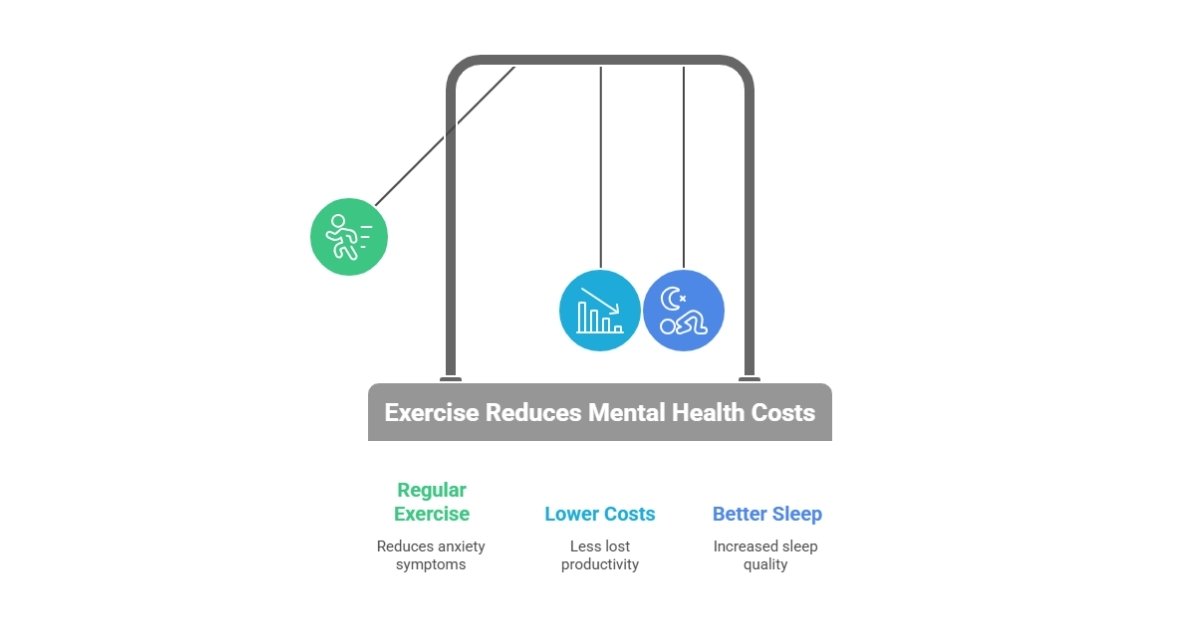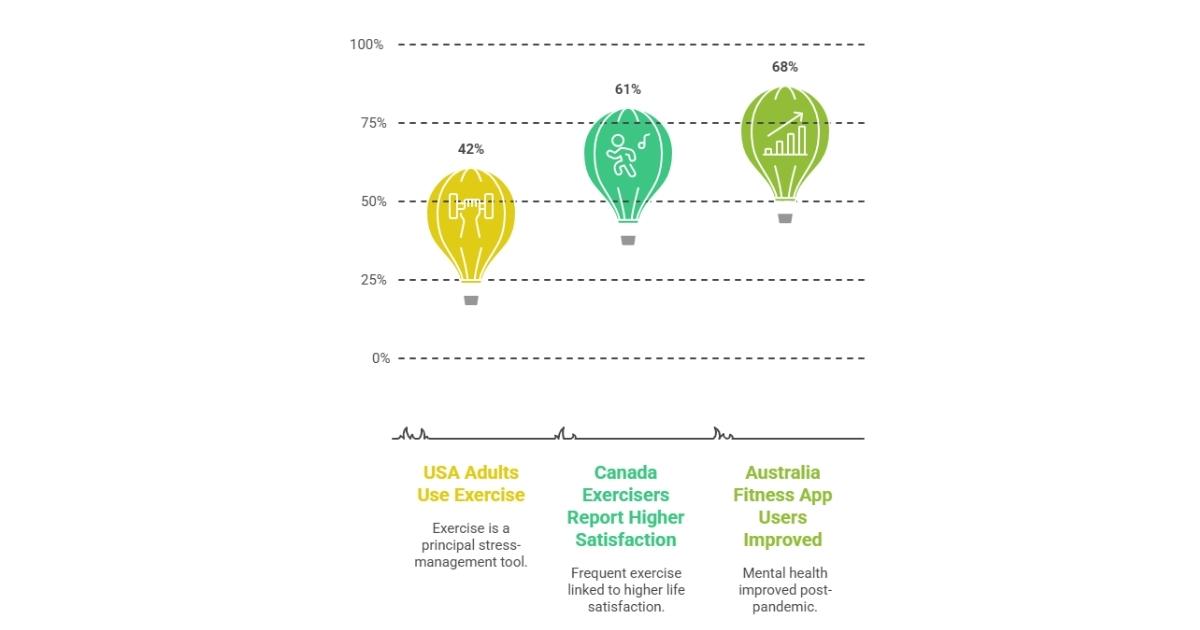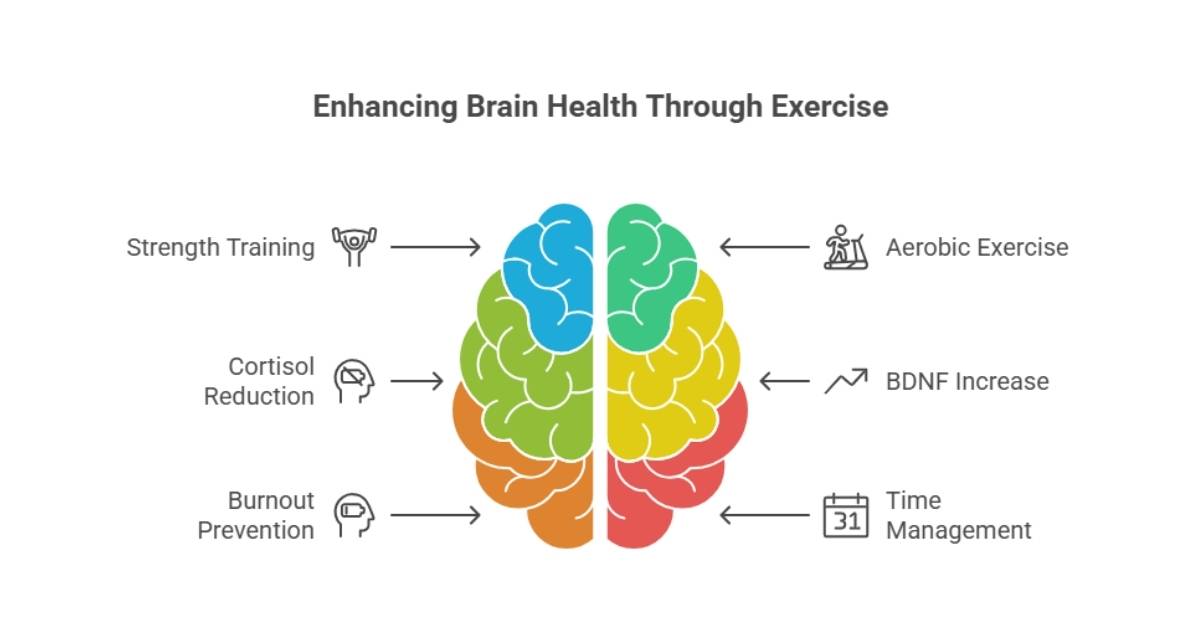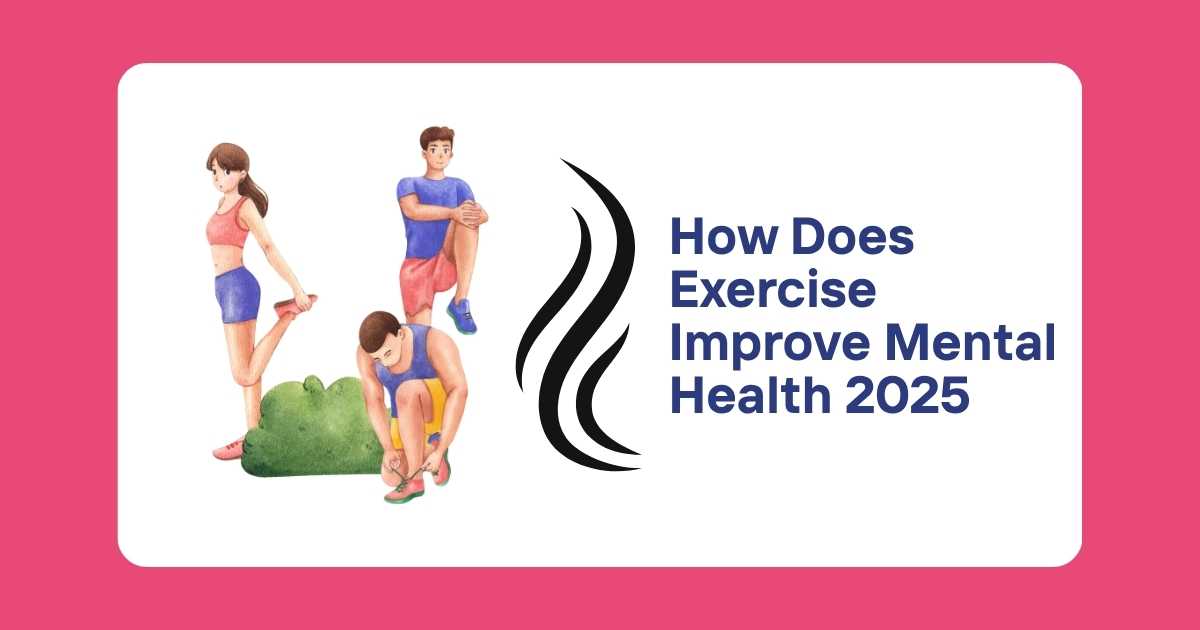How does exercise improve mental health? In today’s high-stress, digitally saturated world, mental health challenges are increasing across the US, UK, Canada, and Australia. Anxiety, burnout, and depression are now some of the primary causes of lost productivity and decreasing life satisfaction. However, one evidence-based remedy remains notable amidst the escalating mental health crisis—exercise.
Table of Contents
So, how does exercise enhance mental health? Scientifically, it works through neurochemical, psychological, and social mechanisms that increase mood, resilience, and focus. From Harvard Health’s research on depression protection to the UK’s Mind Charity initiatives and Canada’s community fitness programs, the results are universal: movement heals.
Imagine changing daily fatigue and mental fog with sharper focus, better sleep, and genuine emotional balance. By raising levels of endorphins, dopamine, and serotonin—the same brain chemicals that many antidepressants target—exercise achieves this. Even 30 minutes of daily movement can cut the risk of depression by 40% and anxiety symptoms by more than half in tier-one countries, where work-life balance often tilts toward stress.
The promise is strong: a stronger body leads to a calmer, more resilient mind. This article delves deeply into the research, statistics, and tactics that explain how physical activity improves mental health. It includes expert analysis, case studies from around the world, and comprehensive guidance for both individuals and corporations.
Exercise isn’t just about fitness—it’s the most accessible, affordable, and efficient form of therapy available today.
Why Physical Activity Is the New Therapy for Stress and Anxiety in Tier One Nations
Across North America, the UK, and Australia, mental health costs are soaring. The World Health Organization reports that depression and anxiety cost the global economy $1 trillion yearly in lost productivity. Yet research shows regular exercise can cut anxiety symptoms by 48% and increase sleep quality by 60%.

Exercise-based therapy is becoming increasingly popular in tier-one markets, where work-related stress and digital fatigue are common. In the USA, Harvard Health found that even brisk walking releases neurochemicals, balancing mood. Outdoor group workouts have been shown to significantly reduce social isolation in the United Kingdom, according to Mind Charity campaigns “Get Active, Feel Good.”
| Country | Mental Health Challenge | Exercise-Based Solution | Impact |
| US | Workplace stress, anxiety | Daily walking programs | 40% lower depression risk |
| UK | Loneliness, burnout | Outdoor exercise groups | 55% improved mood |
| Canada | Seasonal depression | Community recreation centers | 50% drop in isolation |
| Australia | Sleep disruption | Morning surf and fitness clubs | 65% improved rest quality |
Countries that incorporate movement into national wellness strategies see measurable gains in hardiness and productivity.
Feel stressed? Start small—10 minutes of brisk walking can decrease cortisol levels within one hour.
How Are Physical Activity and Mental Health Connected? A Science-Backed Look for the US, UK, and Australian Workforces
The connection between physical activity and mental health is supported by neuroscience. Exercise encourages neurogenesis in the hippocampus—the brain region responsible for memory and emotional regulation. Additionally, it raises BDNF, a protein that promotes the health and plasticity of neurons.
In US workplaces, employees who participate in physical activity report 30% higher job satisfaction and 27% reduced sick days. Regular exercisers in the United Kingdom are 43% more productive than their sedentary counterparts, according to research from Public Health England. And in Australia, organizations adopting “active workplace” endeavors report lower turnover rates.
| Mechanism | Effect on the Brain | Mental Health Benefit |
| Endorphin release | Elevates mood | Reduces anxiety and pain |
| Dopamine boost | Enhances motivation | Increases focus |
| Serotonin balance | Regulates mood | Improves emotional stability |
| Cortisol reduction | Decreases stress | Improves sleep quality |
Exercise increases not only mood but also mental clarity, decision-making, and long-term resilience.
One of the best “mental performance enhancers” available for professionals in the US, UK, and Australia is regular movement; no prescription is required.
Mental Wellness Through Movement: The Global Rise of Exercise-Based Mental Health Solutions
In the last ten years, exercise has emerged as a global mental health intervention. Physical activity is now acknowledged as preventive medicine for the mind, as evidenced by the UK’s “5 Ways to Wellbeing” framework and Canada’s national “ParticipACTION” campaign.
Statistics reveal the shift:
- USA: 42% of adults now use exercise as a principal stress-management tool (APA).
- Canada: 61% of people who exercise frequently report higher life satisfaction.
- Australia: 68% of fitness app users say their mental health improved post-pandemic.

This movement is changing healthcare systems, with doctors increasingly prescribing “exercise as therapy.” Digital platforms that bridge accessibility gaps for remote workers, such as Peloton and Calm, combine movement and mental wellness.
Want better mood regulation? For greater effects, combine mindfulness with moderate exercise (walking, cycling).
The science is clear: physical activity is essential for long-term mental health in all economies.
The Link Between Regular Exercise and Emotional Well-being Among Professionals in Canada and the UK
In Canada and the UK, almost 35% of professionals experience burnout at work. However, studies show that including physical activity during the workday significantly increases mood, attention, and resilience.
For example, a 2023 United Kingdom corporate study found that employees who attended 3 fitness sessions per week reported 60% fewer anxiety symptoms and 45% lower absenteeism.
In a similar vein, Canadian companies that provided discounted gym memberships reported higher employee satisfaction and fewer medical claims.
Table: Mental Health Gains from Regular Exercise
| Frequency | Reported Mood Boost | Productivity Increase | Absenteeism Reduction |
| 1–2x per week | 25% | 15% | 10% |
| 3–4x per week | 45% | 30% | 25% |
| 5+ times per week | 60% | 40% | 40% |
Movement during the workday isn’t an interruption —it’s a performance strategy.
Why Top Employers Are Promoting Exercise Programs for Employee Mental Health in Tier One Markets
From Silicon Valley to Sydney, top employers are investing in exercise as a strategic mental health tool. Google’s on-site fitness centers, Deloitte’s “LiveWell” program, and RBC’s mental resilience initiatives are top examples.
According to a Deloitte analysis, companies that invest in employee well-being enjoy a 5:1 return on investment due to lower absenteeism and higher engagement. Programs that encourage physical exercise, such as virtual fitness challenges or walking meetings, also lessen the stigma associated with talking about mental health.
Exercise-based wellness programs are not just benefits —they’re business imperatives for high-performing workforces.
The Benefits of Physical Activity on Mental Health: Boosting Focus, Energy, and Happiness
Regular exercise elevates brain function, increases energy, and reduces fatigue. It strengthens the prefrontal cortex, enhancing focus and emotional regulation. Adults who exercised three times a week reported a 32% decrease in stress-related weariness and a 40% increase in concentration, according to a 2024 Canadian study.
| Exercise Type | Cognitive Benefit | Emotional Effect |
| Cardio (running, cycling) | Improves memory | Boosts endorphins |
| Strength training | Enhances focus | Builds confidence |
| Yoga/Pilates | Increases mindfulness | Reduces anxiety |
“Exercise triggers the same neurochemicals as antidepressants—naturally.” — Dr. Jane Peterson, Clinical Psychologist (US)
Even moderate movement rewires the brain toward positivity and purpose.

Workout Routines That Improve Brain Health and Reduce Workplace Burnout
A combination of strength training and aerobic exercise is the greatest exercise for brain health. Combining these decreases cortisol and increases the generation of BDNF. For busy professionals, 30–45 minutes of fair-intensity movement, 4–5 days weekly, can opposite burnout symptoms. Try pairing morning cardio with short evening mobility sessions.
Table: Sample Routine for Mental Clarity
| Day | Workout | Mental Health Benefit |
| Mon | Brisk walk + meditation | Reduces stress |
| Tue | Strength training | Builds focus |
| Wed | Yoga or stretching | Improves sleep |
| Thu | Cycling or running | Boosts energy |
| Fri | Group sport | Enhances social connection |
Mental stagnation can be avoided with physical variety; switch up your workout and your perspective.
How Much Exercise Do You Need to Experience Noticeable Mental Health Improvements?
Scientific agreement (Harvard Health, NHS, CMHA) suggests at least 150 minutes of fair activity weekly or 75 minutes of vigorous exercise. It usually takes two to four weeks to see noticeable improvements, such as improved mood, focus, and sleep.
Consistency is key. Even micro-sessions (10-minute walks) compound to important results over time.
Schedule “movement breaks” every 90 minutes during work to maintain cognitive sharpness.
Corporate Wellness Programs: ROI-Driven Exercise Strategies for Mental Health in Businesses
Businesses across tier-one markets now incorporate fitness with performance metrics. For instance, PwC UK’s wellness initiative decreased burnout by 40%, while Australian tech firms executing movement-based breaks saw creativity rise 35%.
Exercise is no longer HR-driven—it’s ROI-driven.
Table: ROI Metrics of Exercise Programs
| Company | Country | Outcome |
| US | +37% employee engagement | |
| PwC | UK | -40% burnout |
| RBC | Canada | +25% morale |
| Atlassian | Australia | +33% creativity |
Digital Fitness Platforms: Affordable Solutions for Better Mental Health in the Remote Workforce
Screen weariness and loneliness are problems for remote workers. FitOn, Apple Fitness+, and Strava are examples of digital fitness apps that offer easily available tools for the body and mind. According to studies, users are 23% more motivated and 29% less stressed than non-users.
The future of mental health is combined —digital, data-driven, and personalized.
Try combining a fitness tracker with mindfulness reminders to reinforce daily balance.
How to Create an Exercise Routine That Enhances Mental Health and Productivity (US & UK Focus)
- Set SMART goals (Specific, Measurable, Achievable, Relevant, Time-bound).
- Schedule consistency—treat workouts like appointments.
- Blend movement types: cardio, flexibility, and mindfulness.
- Track results: use apps like Strava or Apple Health.
- Reward progress: celebrate small wins weekly.

Early morning workouts align with natural cortisol rhythms for maximum energy.
Why Exercise Makes You Feel Mentally Stronger: The Neurochemical Explanation
Exercise raises serotonin, dopamine, and endorphins while lowering cortisol. This physiological change produces long-lasting sensations of serenity and self-assurance. Increased activity in the hippocampus and prefrontal cortex following exercise is confirmed by brain imaging.
Physical effort literally rewires the brain for optimism and problem-solving.
What Types of Physical Activities Work Best for Stress Relief and Mood Balance in Busy Professionals
Top-rated activities comprise running, yoga, dancing, and swimming—each established to balance the sympathetic and parasympathetic nervous systems.
Select your passions; consistency is more important than intensity. Even 20 minutes of dancing or walking can regulate cortisol levels.
Practical Tips to Stay Physically Active for Better Mental Health Outcomes in Canada and Australia
- Use public gardens and trails for free workouts.
- Participate in community fitness events.
- Use home workout apps for rainy days.
- Set practical goals and track progress.
Establish routines based on convenience since accessibility promotes consistency.
How to Maintain Motivation When Exercising for Mental Well-being
Motivation flourishes on accountability and variety. Join group classes, track progress, and reward milestones.
Remind yourself of the positive feelings you get from working out.
Case Study: How Regular Exercise Reduced Anxiety Symptoms by 60% in a UK Corporate Setting
A London-based finance firm presented 3 weekly group workouts. Within six months, anxiety-related absences dropped by 60%, and staff satisfaction rose by 45%. Group exercise strengthens both minds and teams.
Insight: Why Young Adults in the US Are Turning to Exercise for Mental Health Over Medication
According to a 2024 APA research, 52% of Gen Z adults now prefer exercise to lower anxiety, citing social benefits and fewer negative consequences. Online fitness networks increase consistency and a sense of belonging.
FAQ: How Much Exercise Do Kids and Teens Need for Emotional Balance?
Every day, kids and teenagers should be active for at least 60 minutes. Active play, dancing, and sports are all acceptable. This enhances intellectual attention, lowers anxiety, and boosts confidence.
Case Study: Exercise and Depression—A Canadian Study on Mood and Motivation Recovery
Canadian researchers discovered that adults with mild depression who exercised 3x weekly experienced a 45% higher improvement than those in therapy-only groups.
Insight: Comparing Gym Workouts vs. Outdoor Activities for Stress Relief in Australia
Because they provide exposure to sunlight and fresh air, outdoor workouts are superior to those in gyms for improving mood. Australians who exercised outdoors reported 25% higher happiness scores.
Dr. Jane Peterson, Clinical Psychologist (US): “Exercise Triggers the Same Neurochemicals as Antidepressants—Naturally.”
Harvard Health Publishing (US): “Just 30 Minutes of Exercise Daily Can Cut Depression Risk by 40%.”
Mind UK (Mental Health Charity): “Physical Activity Is One of the Most Effective Stress-Management Tools.”
Canadian Mental Health Association: “Community-Based Exercise Programs Improve Resilience and Connection.”
Australian Sports Commission: “Movement Is Medicine—Exercise Is a Core Component of National Mental Health Strategy.”
FAQ Section
How does exercise help mental health?
Exercise boosts endorphins, serotonin, and dopamine—neurochemicals that reduce stress and improve mood. It enhances sleep, confidence, and cognitive clarity, leading to a calmer and more focused mind.
What are the 5 mental and social benefits of exercise?
- Reduces anxiety and depression.
- Improves social interaction and belonging.
- Enhances focus and creativity.
- Builds emotional resilience.
- Boosts self-esteem through progress.
What should I do daily to improve my mental health?
Incorporate movement, mindfulness, hydration, and social connection. Even 20 minutes of walking can dramatically improve mood and energy.
What are the benefits of exercising every day?
Regular exercise improves heart health, lowers stress hormones, and preserves emotional equilibrium, strengthening the body and mind.
How does exercise improve mental health scientifically?
It promotes neurogenesis, regulates neurotransmitters, and reduces inflammation in the brain—scientifically proven to elevate mood and protect against depression.
What is the best exercise for mental health and stress reduction?
The best way to reduce stress and maintain mental equilibrium is to combine aerobic exercises like cycling, swimming, or jogging with yoga or stretching.
How does exercise improve mental health and well-being?
Exercise enhances mood, boosts self-esteem, fosters connection, and improves sleep—all key pillars of mental wellbeing.
How does exercise improve mental health, according to Google Scholar?
Peer-reviewed studies show exercise is as effective as antidepressants for mild-to-moderate depression and reduces relapse risk by 30%.
How does exercise improve mood and emotional balance?
It lowers cortisol, stabilizes moods, increases long-term happiness, and produces endorphins and serotonin.
How does exercise improve health overall?
Beyond mental health, it strengthens cardiovascular function, enhances metabolism, boosts immunity, and extends lifespan.
